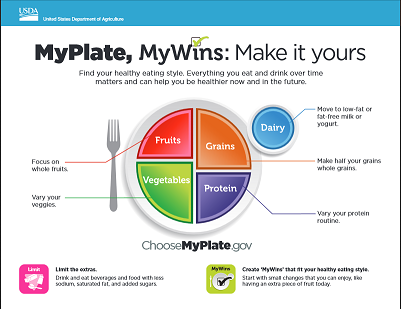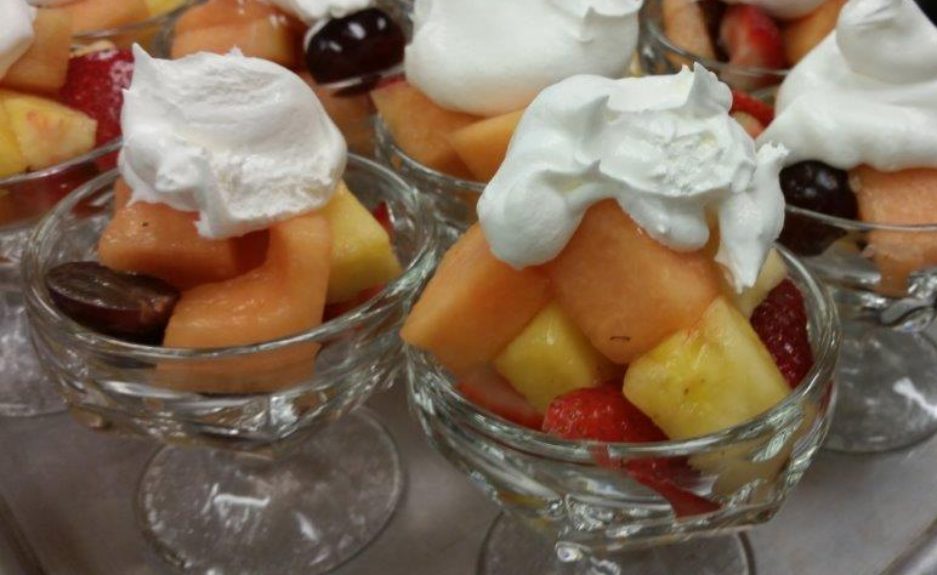How many of you guys are eating a balanced meal? When you hear the  words, “balanced meal,” what does that make you think?
words, “balanced meal,” what does that make you think?
Part of my job at the hospital is to teach nutrition guidelines for soon-to-be-moms. One of the first things that I ask people when we’re talking about creating a balanced meal is, “Are you familiar with the food groups?” I always start there because it’s kind of silly to tell someone to eat protein with their meals if they don’t know which foods contain protein.
There is a wonderful interactive resource available for everyone that’s called MyPlate.

I grew up with the food pyramid… that model changed a few times over the years. Then in 2011, MyPlate was created. I like MyPlate because it’s literally just a plate split up to show you how much of a food group should be on that plate during your meal. Of course it’s important to know how much of each group you should aim for, but you also have to know what foods are even part of those groups! Let’s take a look at dairy, fruits, veggies, grains, & protein foods:
DAIRY: Usually milk is the first food that pops up in the dairy conversation! And if you’re lactose intolerant… that’s OK! Soymilk & lactaid are counted too! Other foods that are considered good dairy sources are yogurt & cheese. Aged cheeses are lower in lactose and the live cultures in yogurt help break down the lactose and help promote a healthy GI tract.
FRUITS: There’s a lot of different fruit out there! Some of the ones you may see all the time are apples, grapes, pears, peaches, bananas, melon, oranges or berries.
GRAINS: The common grains you’re probably most familiar with are foods made from wheat, rice, rye, barley, and oats. These include foods such as breads, rice, hot & cold cereal, crackers, and pasta. A food that can belong to more than one group is corn. I knew we tend to treat corn as just a vegetable, and fresh corn is often counted as a starchy vegetable…. but dried corn is part of the grains group. Items you might see that are made from dried corn are cornmeal, which is used to make a more common dish called polenta, grits, & tortillas.
VEGETABLES: Similar to fruits, there are definitely quite a few vegetables to list everything! Some of the more common veggies include green peas, broccoli, corn, potatoes, cauliflower, squash, plantains, peppers, carrots, and beets.
We should talk about “beans & peas” here for a minute.  Sometimes we have different types of foods that have similar names & it makes people turn into a zombie & swear off all nutrition information forever because it’s so confusing! It’s important to know the differences though, because it helps you plan a more balanced meal. I like to think that saying the words “beans & peas” would be like using just the last name to refer to every member of the same family. Our family members are: green beans, italian beans, wax beans, kidney beans, black beans, lima beans, garbanzo beans (also called chick peas), lentils (sorry lentils… you don’t get 2 names…. but you’re still part of the family!), navy beans, soy beans, mung beans, edamame (another name soloist!), split peas, and green peas.
Sometimes we have different types of foods that have similar names & it makes people turn into a zombie & swear off all nutrition information forever because it’s so confusing! It’s important to know the differences though, because it helps you plan a more balanced meal. I like to think that saying the words “beans & peas” would be like using just the last name to refer to every member of the same family. Our family members are: green beans, italian beans, wax beans, kidney beans, black beans, lima beans, garbanzo beans (also called chick peas), lentils (sorry lentils… you don’t get 2 names…. but you’re still part of the family!), navy beans, soy beans, mung beans, edamame (another name soloist!), split peas, and green peas.
So… any zombies yet?
That giant family will have two sides: vegetables & legumes. The legumes are in the vegetable group, but they get to be in the protein group as well. Because, just like the group name tells us… they contain good sources of plant protein! Here’s a little chart I made so you guys can tell the difference with all the “beans & peas:”
LEGUMES VEGETABLES: (VEGGIES & PROTEIN): -italian beans -lentils -wax beans -navy beans -green beans -peas -soybeans -edamame -kidney beans -garbanzo beans (chick peas) -pinto beans -lima beans -black beans -mung beans
PROTEIN FOODS: Foods in this group include meats, poultry, fish, eggs, nuts & seeds, beans & peas (deja vu!), and soy products.
And those are the food groups! If you look at the MyPlate recommendation, it shows that half of your plate should be fruit and veggies, a little heavier on the veggie side of things! The other half of your plate will be split between a grain and a protein food. And dairy is sitting off to the side as milk, yogurt, or cheese.
There are other things you want to keep in mind as well when you’re trying to plan a balanced meal:
When you go shopping, look for items that are lower in fat. It doesn’t have to be fat free, we need fat in our diet! (Yes… I am definitely plotting a future blog post that will be dedicated to fats…) But for now, just keep in mind that choosing foods like lean cuts of meat or low fat dairy can help keep our heart healthy.
We also should choose whole grains more often! Foods like whole wheat breads, brown rice, whole grain pasta, or oatmeal has a lot of nutrients packed into a single serving. And they have FIBER… one of my favorite carbohydrates as you may recall from a previous blog….
Another component of eating a balanced meal is limiting foods that have added sugar in them. There’s not a lot of nutrition in those types of foods, so we end up with more calories and not much else!
Variety is also a key player. If you like broccoli and you eat it every day, you’re only getting the nutrients that broccoli has to offer. Different foods have different types of nutrients. When we mix up our choices & eat a variety of different foods, we can be more confident that our diet is giving us what we need to stay healthy.
When you read all the steps I have typed out, it might seem like eating a balanced meal is some complicated Rubik’s cube. (Who am I kidding??… they were ALL complicated… I will never solve those things!) But eating well is much less stressful than that evil cube. (It is… I promise!) If you’re reading this and thinking your diet doesn’t sound like anything in this blog and your plate never matches the MyPlate recommendation… hey… that’s ok! I pointed out before that new habits take a long time. Pick ONE thing, and focus on that. If you look at your plate and notice you never have anything with dairy in it, make a point to include dairy. Do that until it feels normal and then focus on the next thing.

I never heard of MyPlate before. What a great way to illustrate food portions!! A lot of great information here. Breaking it down like this makes it so much more clearer. Love your Blog!!
Thanks! The whole site for MyPlate is really cool. It even has a section set up for kids to get involved.